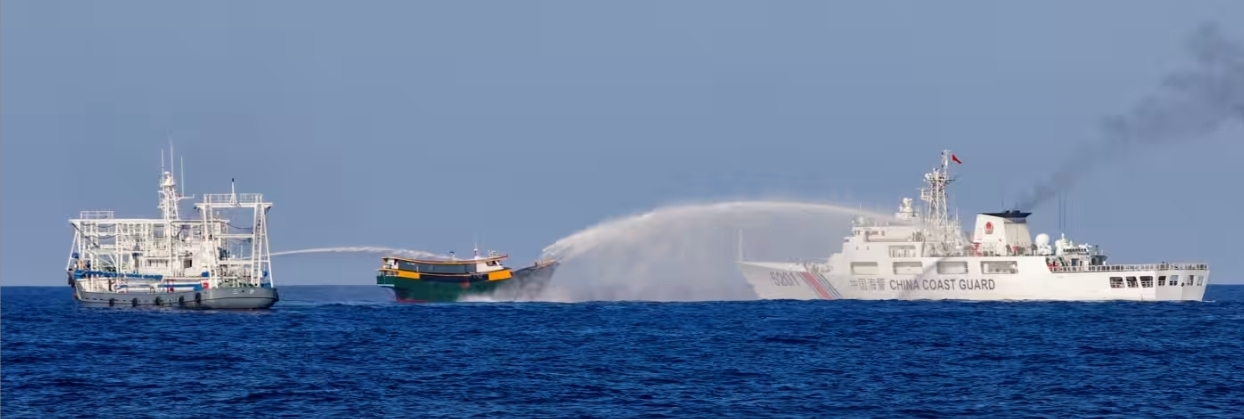Tensions have reached an all-time high in the South China Sea. On June 17, 2024, China’s Coast Guard boarded Philippine resupply ships headed towards Second Thomas Shoal – the latest flare-up in the series of Chinese aggressive actions to assert control over the sea. Such developments in the South China Sea are not new – competition over the Paracel Islands and the Spratly Islands has been going on for decades. To get a full picture of the issue, let us examine the history of the dispute, recent developments, and whether anything can be done to solve the crisis.

The History
China’s claim on pretty much the entire South China Sea is based on the premise that it governed the islands in the sea until 1930. That was not really the case. In reality, the islands were relatively insignificant and ignored by everyone including China until 1933, when France, which controlled Vietnam, claimed the islands in the South China Sea for themselves. Japan took the islands in 1938, which they held until their surrender in the Second World War in 1945, leaving the islands unoccupied for a while. In 1947, the Republic of China claimed the islands, and started marking the islands as part of their territory with an “eleven-dash line”. The Communists continued making this claim when they won the Chinese Civil War in 1949, with the eleven-dash line becoming the nine-dash line. The Republic of China retreated to the island of Taiwan and has still maintained its claim on the islands to the present day. The point is, that China’s argument that its claim on the islands in the South China Sea has a historical basis is flimsy at best, and the six other countries making claims do not respect China’s position.
Why the South China Sea
Now, you may be wondering why countries are squabbling over seemingly irrelevant pieces of land. They are not that irrelevant. The South China Sea is home to around 12% of the world’s fish, and having exclusive fishing rights over these waters means a lot of money. According to an estimate by the U.S. Energy Information Administration, the South China Sea is also home to reserves of between 2.4 billion and 9.2 billion barrels of oil – another moneymaker. Lastly, the sea is one of the most used shipping lanes in the world, with one-third of the world’s shipping passing through it – including 40% of China’s total trade. With a lot of money at stake, it is no wonder why countries are so adamant about getting their hands on the islands.
The Dispute as it Stands
Currently, the islands in the South China Sea is disputed by Brunei, China, Indonesia, Malaysia, the Philippines, Taiwan, and Vietnam, with most occupying at least one island in either the Spratlys or the Paracels. The tension is largely due to the extent of China’s claim – 80-90% of the entire sea is claimed by China. Taiwan, being the Republic of China, lays the same claims as its communist counterpart. Vietnam opposes the Chinese historical account, citing documents from the 17th century that say it ruled over the islands. The Philippines cites its geographical proximity to the Spratly Islands in justifying its claim to part of the islands. Malaysia, Indonesia, and Brunei have also laid claim to territory that they say is part of their exclusive economic zones.
The 2010s
To assert its claims, China began constructing artificial islands in the region in 2013. While the Philippines and Vietnam have also done the same thing, China’s island-building campaign resulted in the construction of more artificial land surface than any of its neighbors. The deployment of military forces by China and other countries has prompted the U.S. and other Western powers to deploy their own ships to bring back order to the area. China has protested this, claiming it violates international law when foreign militaries conduct operations in its exclusive economic zone (EEZ). The U.S. countered by saying that countries should have freedom of navigation rights including military operations, according to the UN Convention on the Law of the Sea. The Philippines has resorted to legal action to try and boost its claims to its disputed territory, winning a 2016 case it brought against China at the Hague. China ignored this ruling and has continued asserting itself. The U.S. has vowed to support the Philippines, citing its defense treaty with Manila, and has conducted freedom of navigation operations in the South China Sea. Since late 2019, the Philippines has become assertive in pursuing its claims to the South China Sea. Then-President Duterte, long known for his skepticism of the U.S., reversed a planned cancelation of U.S. troops’ stay in the country and drew closer to Washington in the waning time of his presidency.
Recent Developments
In 2022, Ferdinand Marcos Jr. was elected President of the Philippines, signaling a closer partnership with the West. His presidency saw him strengthen relations with partners in the Indo-Pacific, including signing deals increasing base access and joint exercises with the United States. In 2023, Chinese Coast Guard vessels began harassing Philippine resupply missions to the Second Thomas Shoal in the Spratly Islands, where the Philippines had intentionally grounded a ship there to assert its claim and has regularly sent military aid ever since. China has upped its harassment campaign here, using military-grade lasers and firing water cannons against Philippine ships.
The disputes over the islands in the South China Sea remain unresolved. There is still potential for a possible China-Philippine conflict over the islands, with Washington likely to be pulled in due to its friendship treaty with Manila. ASEAN, which consists of 10 Southeast Asian countries including several of the countries involved in the dispute, has remained divided over how to resolve the dispute. There appear to be no bilateral negotiations as of late. One wrong move by either side can trigger war in the region and cause damage to the economies and stability of the Asia-Pacific region.
Possible Solutions and their Viability
Over the years, many solutions to this complicated issue have been considered. We’ll examine three possible solutions to the conflict and their merits.
The United Nations Method
Many have called for the United Nations to step in and call for China to at least relax its claims in the South China Sea. However, China’s history of failing to abide by international law makes this unlikely to produce results. China’s status as a permanent member of the Security Council would end any resolution introduced that is contradictory to its claims. Even if a resolution were to pass in the United Nations General Assembly there would be no enforcement mechanism and China would not respect it.
The Assertive One
This option is the most destructive one. The Philippines and other countries could choose to push back on Chinese claims militarily and force naval ships to turn around. This would be a death sentence for any country that would choose this option since their military and naval forces are no match for the second-most-powerful armed forces in the world. More worryingly, a Philippine-Chinese conflict would most likely involve the U.S. due to its mutual defense treaty with Manila. A war involving the two largest economies in the world would not be beneficial for the global economy and the world at large.
Talking to China
The most realistic solution that exists right now is for the countries involved in the South China Sea dispute to talk to one another. Many of the countries involved in the dispute are members of the Association of Southeast Asian Nations (ASEAN) and have argued that the bloc should arrange negotiations with China. China, however, opposes this and has given a preference towards bilateral talks with its neighbors. It has been argued though that China’s size and global influence give it an unfair advantage over the other side. ASEAN remains divided over the dispute and multiple rounds of talks have occurred in the past decade, none of which have contributed to a meaningful solution in the South China Sea. However, it is worth giving another try.
The Ideal Scenario
In my opinion, the best the world can hope for to resolve the conflict in the South China Sea would be for a change in Chinese policy. For a long time now, China’s policy has centered on pursuing its maritime claims, and under Xi Jinping, such policy has only gotten more aggressive. Dozens of talks have gone nowhere and China is still unwilling to moderate its claims on the South China Sea. If China’s Communist Party were to select new leaders that would reverse Beijing’s harsh stance on the sea then that would help to ease tensions in the South China Sea. Peace in the South China Sea can only be achieved by a shift in China’s attitude.
Sources:
https://www.cfr.org/global-conflict-tracker/conflict/territorial-disputes-south-china-sea
https://www.eia.gov/international/analysis/regions-of-interest/South_China_Sea
https://www.bbc.com/news/world-asia-pacific-13748349
https://www.brookings.edu/articles/xi-jinping-and-chinas-maritime-policy/
Emil Ordonez, a rising college freshman, is the founder and editor-in-chief of Polinsights. He has been deeply passionate about politics and history since learning every U.S. President at the age of five. He was compelled to start this blog after meeting many people who were misinformed or had become apathetic about how society worked. He hopes to provide factual knowledge and insights that will encourage people, especially the young, to get more engaged in their respective communities. In his free time, he edits for Wikipedia and makes maps for elections. He aspires to work in Congress or even the White House in the future.


Leave a Reply